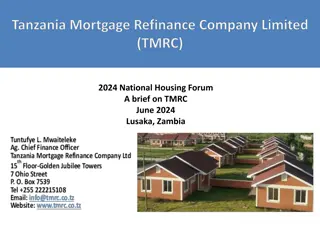Lending Session
Explore different types of loan options such as short-term, intermediate, and long-term loans. Learn about the Cs - Credit History, Collateral, Capital, Capacity, and Conditions - that determine loan access. Understand the importance of credit scores, capital, collateral, and capacity in the loan application process.
Download Presentation

Please find below an Image/Link to download the presentation.
The content on the website is provided AS IS for your information and personal use only. It may not be sold, licensed, or shared on other websites without obtaining consent from the author. Download presentation by click this link. If you encounter any issues during the download, it is possible that the publisher has removed the file from their server.
E N D
Presentation Transcript
Lending Session Prepared by: Charles Danso, PhD Financial Fitness Program, CSULA Fall 2021 Please do not use or duplicate without permission from the author, Charles Danso Email: cdanso@calstatela.edu
Types of Loans Term to maturity Short: Example credit cards (can be intermediate too), Intermediate: Example- Auto Loan, personal loan Long-term: Example- Student Loan, Mortgages Secure (Collaterized) & Non-secured Debt E.g. credit cards, Purpose Home Purchase: Mortgage Education: Student Loans Car Purchase: Auto Loan Home Construction: Construction loan Debt Consolidation Personal Loan Revolving Credit: Credit cars, and store cards
The Cs to Accessing loans Credit History & Score (Character) Collateral Capital Capacity Conditions (of loan)
Credit Scores Includes FICO & other credit history reports Used in determining the interest rate for borrower. The higher, the more favorable rates & types of credit one is likely to get.
Capital How much money you can put down It s used to show readiness/seriousness of borrower.
Collateral Collateral is a asset received as security of the loan. Helps to offset default by borrower Can be investment accounts, land, home, automobile. Cash accounts & investment accounts are more common in the US. The higher the value of the collateral, the higher likelihood of having lower the payments all else constant. Similarly, one can access a higher loan value with a higher valued collateral.
Capacity Capacity gauges the ability of borrower to repay loan against existing recurring debt and evaluating debt to income ratios. Joe Exotic makes $120,000 before taxes (gross income) Item Monthl y Annual/Total Value Note: Some loans do not use all or certain expenses in determining capacity. Some may use additional expenses not shown here. Income $10,000 $120,000 Car Loan $300 $3,600 Student Loan $700 $6,000 Credit Cards $100 $1,200 Personal Loan $450 $5,400 For example: home loans do not include rental expense in determining capacity. Rent $1,600 $19,200 $37,800 Total Expenses $3,150 Balance $6,850
Applying to Home Purchase Mr. Exotic wants to explore buying a $500,000 home. Item Case 1 Case 2 Case 3 Case 4 Home Value $500,000 $500,000 $500,000 $500,000 These numbers are made up for illustrative purposes Credit Score Excellent Good Excellent Average Down Payment 3.5 15 20 3.5 Keep in mind mortgage includes expenses such as home owner s insurance, taxes, mortgage insurance (PMI) if down payment is less than 20%, possibly Home owner s association (HOA) fees. Interest rate 2.75% 3.15% 2.5% 3.75% Loan Term (Years) 30 30 30 30 Frequency (monthly) 12 12 12 12 Income after recurring debt $8,450 $8,450 $8,450 $8,450 FHA Loan cap (45%) [$3,802.50] $931,435 $884,844 $962,364 $821,069 The different cases examine scenarios with different down payments & credit scores Conventional loan cap (35%) [$2,957.50] $724,449 $688,212 $748,505 $638,609 Principal & interest payments $1,970 $1,826 $1,580 $2,235
Summary of Examples (from slide 8) The examples in slide 8, are for illustration. Lenders may use more detailed and advanced formulas to determine loan. However, logic is similar. Rows 8 & 9 show much monthly payments one is capable of handling based on the capacity limits of different loan types. The maximum payment amount is highlighted in red. The payment amount is used to determine the maximum home value one can afford in the table. The last row from table show the principal & interest payments for the different scenarios when looking to purchase a $500,000 home. Where interest rates differ from differences in credit scores. When down payments amounts differ.
Credit & Credit Repair (Misc.) Consolidation loan Credit Repair (Warning) Closing revolving accounts Co-signing & co-application

















































